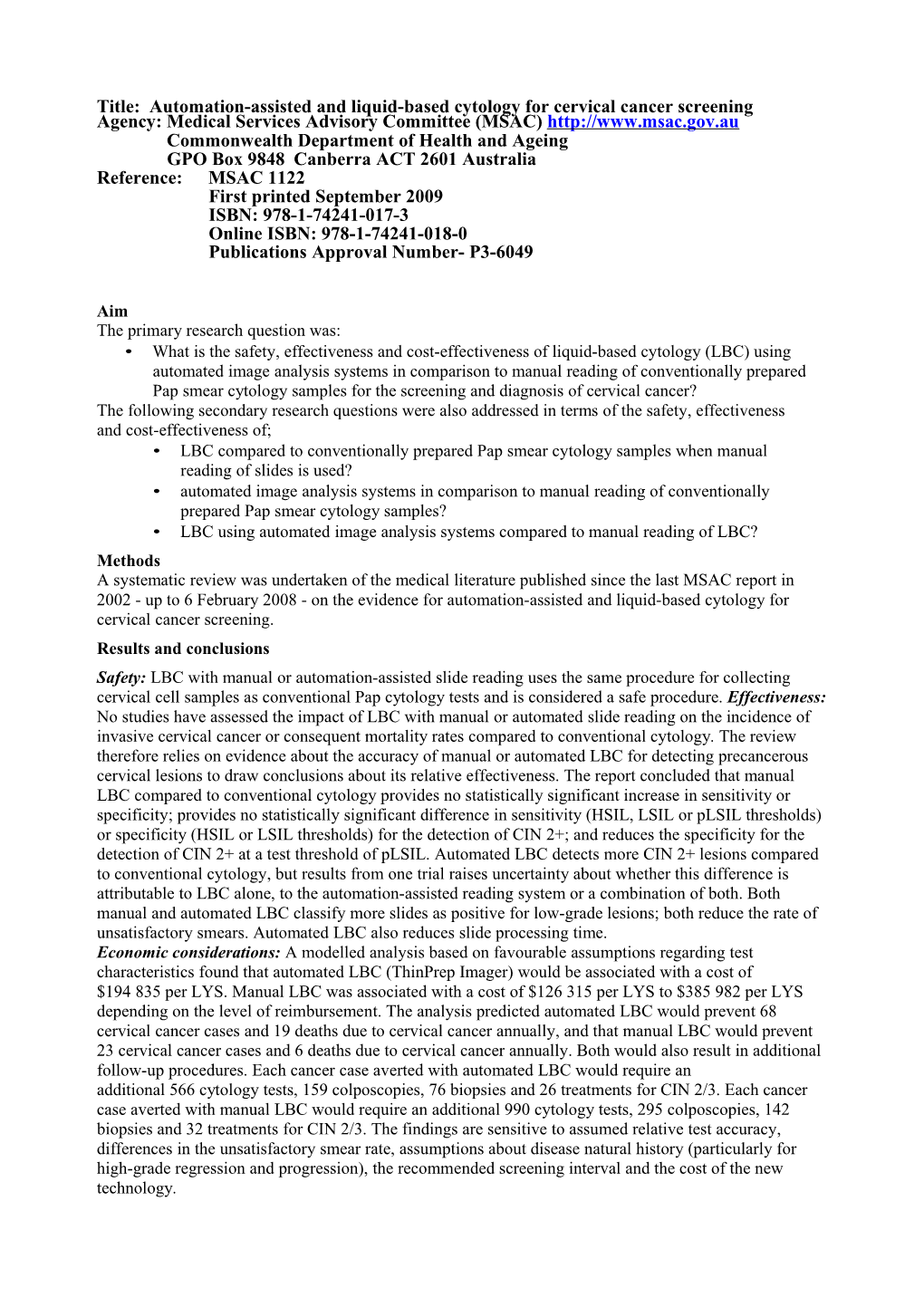Title: Automation-assisted and liquid-based cytology for cervical cancer screening
Agency: Medical Services Advisory Committee (MSAC) http://www.msac.gov.au
Commonwealth Department of Health and Ageing
GPO Box 9848 Canberra ACT 2601 Australia
Reference: MSAC 1122
First printed September 2009
ISBN: 978-1-74241-017-3
Online ISBN: 978-1-74241-018-0
Publications Approval Number- P3-6049
Aim
The primary research question was:
• What is the safety, effectiveness and cost-effectiveness of liquid-based cytology (LBC) using automated image analysis systems in comparison to manual reading of conventionally prepared Pap smear cytology samples for the screening and diagnosis of cervical cancer?
The following secondary research questions were also addressed in terms of the safety, effectiveness and cost-effectiveness of;
• LBC compared to conventionally prepared Pap smear cytology samples when manual reading of slides is used?
• automated image analysis systems in comparison to manual reading of conventionally prepared Pap smear cytology samples?
• LBC using automated image analysis systems compared to manual reading of LBC?
Methods
A systematic review was undertaken of the medical literature published since the last MSAC report in
2002 - up to 6 February 2008 - on the evidence for automation-assisted and liquid-based cytology for cervical cancer screening.
Results and conclusions
Safety: LBC with manual or automation-assisted slide reading uses the same procedure for collecting cervical cell samples as conventional Pap cytology tests and is considered a safe procedure. Effectiveness: No studies have assessed the impact of LBC with manual or automated slide reading on the incidence of invasive cervical cancer or consequent mortality rates compared to conventional cytology. The review therefore relies on evidence about the accuracy of manual or automated LBC for detecting precancerous cervical lesions to draw conclusions about its relative effectiveness. The report concluded that manual LBC compared to conventional cytology provides no statistically significant increase in sensitivity or specificity; provides no statistically significant difference in sensitivity (HSIL, LSIL or pLSIL thresholds) or specificity (HSIL or LSIL thresholds) for the detection of CIN 2+; and reduces the specificity for the detection of CIN 2+ at a test threshold of pLSIL. Automated LBC detects more CIN 2+ lesions compared to conventional cytology, but results from one trial raises uncertainty about whether this difference is attributable to LBC alone, to the automation-assisted reading system or a combination of both. Both manual and automated LBC classify more slides as positive for low-grade lesions; both reduce the rate of unsatisfactory smears. Automated LBC also reduces slide processing time.
Economic considerations: A modelled analysis based on favourable assumptions regarding test characteristics found that automated LBC (ThinPrep Imager) would be associated with a cost of
$194 835 per LYS. Manual LBC was associated with a cost of $126 315 per LYS to $385 982 per LYS depending on the level of reimbursement. The analysis predicted automated LBC would prevent 68 cervical cancer cases and 19 deaths due to cervical cancer annually, and that manual LBC would prevent 23 cervical cancer cases and 6 deaths due to cervical cancer annually. Both would also result in additional follow-up procedures. Each cancer case averted with automated LBC would require an
additional 566 cytology tests, 159 colposcopies, 76 biopsies and 26 treatments for CIN 2/3. Each cancer case averted with manual LBC would require an additional 990 cytology tests, 295 colposcopies, 142 biopsies and 32 treatments for CIN 2/3. The findings are sensitive to assumed relative test accuracy, differences in the unsatisfactory smear rate, assumptions about disease natural history (particularly for high-grade regression and progression), the recommended screening interval and the cost of the new technology.
The results presented are based on the current screening program in Australia without taking into account potential changes resulting from HPV vaccination.
